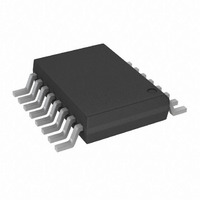TC1043CEQR Microchip Technology, TC1043CEQR Datasheet - Page 8

TC1043CEQR
Manufacturer Part Number
TC1043CEQR
Description
IC DUAL OPAMP/COMP W/VREF 16QSOP
Manufacturer
Microchip Technology
Type
Amplifier, Comparator, Referencer
Datasheet
1.TC1043CEQR.pdf
(20 pages)
Specifications of TC1043CEQR
Package / Case
16-QSOP
Applications
General Purpose
Mounting Type
Surface Mount
Number Of Channels
2 Channels
Output Type
Push-Pull
Response Time
4 us
Offset Voltage (max)
1.5 mV
Input Bias Current (max)
100 pA
Supply Voltage (max)
5.5 V
Supply Voltage (min)
1.8 V
Supply Current (max)
30 uA
Maximum Operating Temperature
+ 85 C
Mounting Style
SMD/SMT
Minimum Operating Temperature
- 40 C
Lead Free Status / RoHS Status
Lead free / RoHS Compliant
Available stocks
Company
Part Number
Manufacturer
Quantity
Price
Company:
Part Number:
TC1043CEQRTR
Manufacturer:
MICROCHIP
Quantity:
12 000
Part Number:
TC1043CEQRTR
Manufacturer:
MICROCHIP/微芯
Quantity:
20 000
TC1043
Capacitor C1 will charge up through R4. When the volt-
age at the comparator’s inverting input is equal to V
the comparator output will switch. With the output at
ground potential, the value at the non-inverting input
terminal (V
value given by:
EQUATION 4-7:
Using the same resistors as before, capacitor C1 must
now discharge through R4 toward ground. The output
will return to a high state when the voltage across the
capacitor has discharged to a value equal to V
period of oscillation will be twice the time it takes for the
RC circuit to charge up to one-half its final value. The
period can be calculated from:
EQUATION 4-8:
The frequency stability of this circuit should only be a
function of the external component tolerances.
Figure 4-8 shows the circuit for a pulse width modulator
circuit. It is essentially the same as in Figure 4-7 with
the addition of an input control voltage. When the input
control voltage is equal to one-half V
basically the same as described for the free-running
oscillator. If the input control voltage is moved above or
below one-half V
wave will be altered. This is because the addition of the
control voltage at the input has now altered the trip
points. The equations for these trip points are shown in
Figure 4-8 (see V
Pulse width sensitivity to the input voltage variations
can be increased by reducing the value of R6 from
10kΩ and conversely, sensitivity will be reduced by
increasing the value of R6. The values of R1 and C1
can be varied to produce the desired center frequency.
4.8
The majority of spectral energy for human voices is
found to be in a 2.7kHz frequency band from 300Hz to
3kHz. To properly recover a voice signal in applications
such as radios, cellular phones, and voice pagers, a
low power bandpass filter that is matched to the human
voice spectrum can be implemented using MIcrochip’s
CMOS op amps. Figure 4-9 shows a unity gain multi-
pole Butterworth filter with ripple less than 0.15dB in
the human voice band. The lower 3dB cut-off frequency
is 70Hz (single order response), while the upper cut-off
frequency is 3.5kHz (fourth order response).
DS21347B-page 8
Voice Band Receive Filter
L
---------------- -
FREQ
) is reduced by the hysteresis network to a
1
DD
H
, the duty cycle of the output square
and V
=
V
2 0.694
L
(
=
L
).
V
---------- -
3
DD
) R4
(
) C1
(
DD
)
, operation is
L
. The
H
,
4.9
Supervisory Audio Tones (SAT) provide a reliable
transmission path between cellular subscriber units
and base stations. The SAT tone functions much like
the current/voltage used in land line telephone systems
to indicate that a phone is off the hook. The SAT tone
may be one of three frequencies: 5970, 6000 or
6030Hz. A loss of SAT implies that channel conditions
are impaired and if SAT is interrupted for more than 5
seconds a cellular call is terminated.
Figure 4-10 shows a high Q (30) second order SAT
detection bandpass filter using Microchip’s CMOS op
amp architecture. This circuit nulls all frequencies
except the three SAT tones of interest.
Supervisory Audio Tone (SAT)
Filter for Cellular
©
2002 Microchip Technology Inc.


















